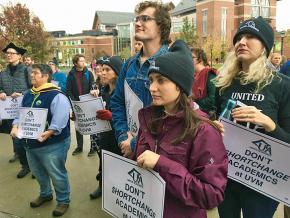UVM faculty advance with a new contract
The new contract for faculty at the University of Vermont contains some important concessions from the administration, but until the budget prioritizes academics, there will continue to be pressure on academic workers, explain and .
AFTER MORE than 15 months of negotiations, members of United Academics AFT-AAUP ratified a new contract for the University of Vermont’s full-time faculty. The agreement maintains current benefits, staves off objectionable intellectual property language, and makes some advances in promotion increases, faculty development funds and workload language.
It also provides an 8.5 percent salary increase over the three years of the contract — 2.5 percent above the administration’s proposed 6 percent. An external “fact finder,” enlisted when negotiations and mediation failed to produce an agreement, sided with the union in citing a “continuing need to increase the bargaining unit’s salaries to be more in line with their comparable peers.”
The union’s pushback against the administration’s sub-inflation salary proposal also ensures that, in the face of rising health-care premiums, faculty don’t see their take-home pay decrease.

The downside of this contract is that salary increases are only retroactive to January 2018 not July 2017, when the last contract expired. The fact finder cited declining tuition revenue as justification for this decision. Lack of full retroactivity both cuts into the salary increase and sets a worrying precedent in giving the administration an incentive to stall negotiations in the future.
The claim of declining tuition revenue also bolsters the administration’s assertions that the university is cash-strapped and cannot afford to fully fund the curriculum.
Even before the contract was settled, the administration had embarked on deep cuts in the College of Arts and Sciences, leading to course cancellations and layoffs of non-tenured faculty. The new contract provides little defense against the administration’s plans to eliminate 70 full-time college positions over the next five years.
Yet the union has found that despite decreasing enrollments — part of a national trend — the financial health of the university is strong.
The “budget deficit” in the College of Arts and Sciences is a manufactured crisis, created by an “incentive-based budgeting” model that artificially underfunds academics to “incentivize” departments to find cheaper ways to deliver instruction and to compete against one another for students.
Union investigation into university spending has also found that administrators are prioritizing short-term image over long-term academic health. While cutting teaching faculty, the university spent $1.6 million on a branding consultant, $3 million on construction of a new bridge between a student dorm and the library, and announced fee hikes in order to finance a new $80-million sports facility.
An analysis by the American Association of University Professors found that UVM spends far less on academics compared to peer institutions; only $1 out of $3 of the operating budget is spent on faculty teaching and research.
THE UNION has consistently argued that the way to respond to declining enrollments is to invest in education and to cut “from the top” by trimming administrative positions and scaling back on expensive discretionary projects.
The cancellation of 12 classes this spring saved an estimated $70,000 to $150,000. The annual cost of salary and fringe benefits for just three of the university’s vice presidents is $1 million.
Throughout the long months of negotiation, the union has run a contract campaign to inform faculty about the university’s misplaced spending priorities and to encourage unity across the competitive divides created by austerity budgets. Under the slogan, “Don’t shortchange academics at UVM,” the campaign included outreach to students and the broader community.
With an administration still intent on funding amenities while cutting faculty, United Academics can’t afford to mothball this campaign. Negotiations for part-time faculty have just started — with the administration expected to propose alarming rollbacks of past contract gains.
Full- and part-time faculty together face an ongoing struggle to defend what we’ve won previously and to stave off further cuts to classes and faculty. While the contract for full-time faculty is far better than anything the administration had proposed, it is clear that these fights are just beginning.
Importantly, these fights take place in a landscape of rising struggle. Nationally, the #RedForEd movement has scored victories for public education in states hardest hit by defunding and where teachers have the fewest (or no) collective-bargaining rights.
Next door, at the University of Vermont Medical Center, the AFT nurses’ union has mobilized hundreds of members and supporters against administrators who value profit over patients. The nurses have said no to mediators, no to fact-finders, and yes to solidarity.
Recent teachers’ struggles that have already won impressive gains share some common strategies: internal organizing to increase active participation; sustained solidarity outreach to students, parents, and the community; and mass actions that send a message of unity and strength.
United Academics will need to draw on these examples in the continuing effort to win strong contracts, defend against ongoing attacks, and challenge the current priorities at the university.


